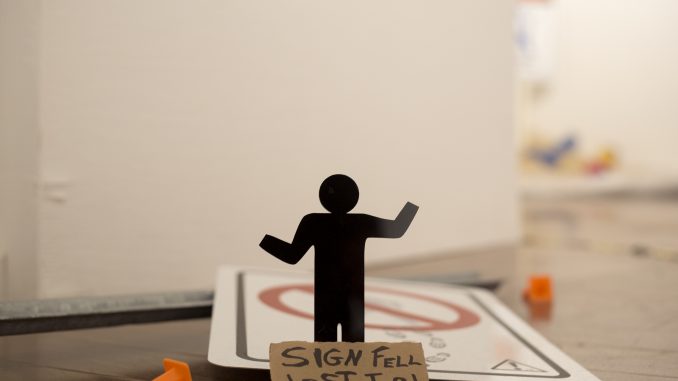
Like a sandcastle that washes away after a powerful wave, some of Joe Boruchow’s street art can disappear under a new coat of paint at any moment.
“They get painted over because they’re not commissioned and probably not legal—well, definitely not legal. So I couldn’t tell you where any are with any degree of certainty,” said Boruchow of his mailbox series—a string of images he recreates onto relay mailboxes using wheatpaste, a flour-based mixture.
Boruchow’s art remains preserved off the streets for the next month in “Intersections.” The Paradigm Gallery + Studio exhibit on 4th Street near Fitzwater, features Boruchow’s stark stenciled creations and anonymous artist Kid Hazo’s playful parodies, both of which have been sprinkled onto surfaces in Philadelphia.
Although Boruchow and Hazo’s works fall under the umbrella term “street art,” Sara McCorriston, Paradigm’s co-founder and director, advises the art appreciator to acknowledge the diversity and ambiguity the genre possesses.
“I’m always hesitant to even use the term,” McCorriston said. “‘Street art’ is good to connect with people and kind of start off on a page everyone can understand from, but it really isn’t all that descriptive.”
Boruchow began his interaction with public art when, as a young teenager, he dispersed copies of Keith Haring’s “Free South Africa” posters around his school to protest the ongoing apartheid movement on the other side of the world.
Years later, the Arlington, Virginia native moved to Philadelphia and plastered his own distinctive creations throughout the city—this time, to advertise the Nite Lights, his rock band. His utilization of homemade stencils soon became a distinctive artistic technique.
Today, Boruchow’s work features intricate iconography that often caters to Philadelphian history. His upcoming mural on 33rd and Oxford streets, at the request of the Strawberry Mansion Neighborhood Civic Association, will pay tribute to local legends including John Coltrane and Dotty Smith.
Boruchow makes sure his work is no secret, whether it’s commissioned by the city’s Mural Arts Program or inspired by a personal venture.
“I’m not trying to be on the down low about it,” Boruchow said. “I’m there doing it in broad daylight.”
The second artist featured in “Intersections” uses a different approach.
“I’m, like, super low-key,” Hazo told The Temple News.
While Hazo’s pieces are recognizable, his face is anything but; the artist keeps his identity undisclosed, making his work both prankish and mysterious.
Hazo installs his art during odd hours of the night, cloaked in a hoodie and mask during a hot summer day, or disguised in Dickie’s apparel as the average city worker assembling a street sign. Hazo prefers to leave his persona open to the imagination.
“It gives the art more of a focus and attention than worrying about who I am and what I’m doing in my personal life or anything like that,” Hazo said.
Hazo’s work satirizes modern Philadelphian culture. For example, his April 1 installation, “Le Poo,” turned Claes Oldenburg’s famous sculpture of a glob of paint into the infamous iPhone emoji outside of the Pennsylvania Academy of Fine Arts on 15th Street near Cherry.
“It becomes this group crowd thing, this inside joke that a lot of people get to be in on, instead of ‘This artist makes this,’” McCorriston said. “There’s a difference there.”
Hazo’s featured works include “Queen of Jeans,” a riff on the iconic, recently removed “King of Jeans” sign on East Passyunk Avenue.
McCorriston said while Hazo and Boruchow’s styles differ, they inevitably intersect—each artist, through a public mural or an incognito installation, pays a tribute to the city.
“I find that more street artists than others concentrate on getting their work everywhere they possibly can,” McCorriston said, “and these artists really concentrate on Philadelphia.”
Angela Gervasi can be reached at angela.gervasi@temple.edu.



Be the first to comment